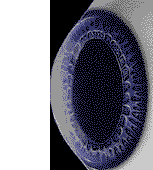
LASIK
(Laser In-Situ Keratomileusis)

| The painless lasik surgery is the most advanced procedure to date for correcting both nearsighted and farsighted vision. The 15 minute Refractive Surgery begins by the surgeon creating a small flap (about 3 hairs thick) in the cornea called a lenticule. This is achieved by the use of a tool called a microkeratome. This instrument is extremely precise, it has delicate gears that run within tracks on a suction ring gently gliding over the cornea. Then in less than 90 seconds, ultraviolet |
 |
What is Refractive Surgery?
Refractive surgery is a general term that describes a number of surgical procedures used to correct nearsightedness, farsightedness, and astigmatism. These conditions are called refractive errors because they prevent light from focusing properly on the retina and thereby cause blurred vision.
The word refract means "to bend." If you have perfect vision, your eyes bend light exactly the right amount so it focuses precisely on the retina. But if you have a refractive error like nearsightedness, your eyes fail to bend light to the degree required to form that perfect focus and your vision is blurred.
Refractive surgeries improve vision by reshaping the curvature of the front of the eye (the cornea). This improves the accuracy of how your eyes bend light to achieve better focus on the retina and clearer vision without glasses or contact lenses.
There are two general types of refractive surgery. One type is performed with a special type of diamond surgical knife. Examples of this type of refractive surgery (also called "incisional procedures") are Radial Keratotomy (RK) and Astigmatic Keratotomy (AK).
The second type of refractive surgery is performed using a special laser called the excimer laser. The excimer laser has an interesting history. It was developed in the early 1980's by IBM to etch computer chips. Soon afterward, researchers discovered it had excellent characteristics for use in refractive surgery.
Before the excimer laser, lasers used for medical purposes damaged surrounding tissues due to excessive heat. In contrast, the "cool" light of the excimer laser enables the surgeon to operate on very small areas of the body without causing heat damage to surrounding tissues. The excimer laser also allows the surgeon to make very clean "cuts" with well-defined margins.
The excimer laser changes the shape of the cornea by removing thin layers of corneal tissue with pulses of high-energy ultraviolet light. Each pulse lasts about one billionth of a second. The excimer laser can be directed with tremendous precision. The laser beam is so fine that it takes over 200 pulses to etch through a single strand of human hair.
Candidates for the lasik procedure
If you fit these criteria you can make an appointment to see our specialists for a surgery consultation.
You must be at least 18 years of age.
You should have healthy eyes, free of any scarring from previous injury, or infection.
Nearsighted or farsighted patients are candidates
You should NOT have the procedure if you have collagen vascular, auto immune or immunodeficiency diseases. (AIDS, lupus, etc.)
You should NOT have the procedure if you are pregnant or nursing.
You should NOT have the procedure if you have keratoconus.
You should NOT have the procedure if you are taking medications such as Accutane (isotrtinoin), or Cordarone (aminodarone hydrochloride)